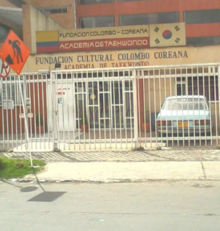Draft:Asian-Colombians
 Korean-Colombian Cultural Foundation in Bogota, Colombia | |
| Regions with significant populations | |
|---|---|
| Bogotá, Barranquilla, Cali, Cartagena, Medellín, Santa Marta, Neiva, Manizales, Cúcuta, Pereira | |
| Languages | |
| Colombian Spanish, Chinese, Japanese, Korean, Languages in India, Arabic, Vietnamese, Armenian, Turkish, Thai, Filipino, Malay. | |
| Religion | |
| Buddhism, Catholicism, Hinduism, Islam, Protestantism, Shintoism, Sikhism | |
| Related ethnic groups | |
| Asians, Arabs, Colombians, Arab Colombians |
The term Asian-Colombians (spanish: colombianos asiáticos) refers to Asian immigrants in Colombia and their descendants. The majority of Asian-Colombians are of Chinese and Japanese descendent,[1][2][3][4][5][6] with a smaller portion being of Korean descendent. There are also notable South Asian, Southeast Asian, Arab, and Asian Middle Eastern descending populations. [7][8]
History
In 1854, many Chinese migrants arrived in Colombian territory for the construction of the Panama Canal Railway across the Isthmus of Panama, as the domestic labor force was not sufficient enough.[9] Around 705 Chinese immigrants came from the Guandong province,demonstrating their skills working on the construction of the first Transcontinental Railroad on the west coast of theUnited States. The Chinese migrants being brought into the projects was a desperate measure by the managers of the railway companies, who did not have enough workers among the native population for the construction and failed to import enough Irish, German, and other European migrants to make up for the deficit .[9][10]
At the beginning of the 20th century, Indian Muslim migrants settled in the towns of the Cauca River valley, some just temporarily and others permanently, to engage in the commercial activity demanded by the new working population of the nascent sugar industry. These immigrants brought a variety of products to rural areas, both granting credit and accepting barter.[8]
Toraji Irie, a renowned Japanese writer, states in his work on Japanese migration to other regions of the World that the first Japanese migrants who arrived in Colombia in 1903, the year Panama gained independence and Colombia lost control of the Isthmus of Panama, came as a result of the Colombian Government seeking help from Japan in hiring workers to guard land bordering Panama against U.S. incursions.[11]
In 1928, this was the smallest migratory group, being somewhat small compared to other South American countries like Brazil, Peru or Venezuela. Despite this, some Japanese families began settling in Valle del Cauca,[12] where many became farmers. Between 1970 and 1980, there was a small yet constant flow of Asian migration (mainly from China) into Colombian cities- primarily Bogotá, Barranquilla, Cali, Cartagena, Medellín, Santa Marta, Neiva, Manizales, Cúcuta and Pereira- which continues to this day. Other very small groups of Asian migrants came from India[7], Indonesia, Pakistan and the Philippines.
Between 1970 and 1980 there were more than 6,000 Chinese Immigrants in Colombia, meaning that they continued to arrive and grow in population. Anti-Immigration policies in many other countries is a possible primary cause of continued Chinese immigration into Colombia. Emigration out of China into Colombia generally did not occur the first three decades following the establishment of the People's Republic of China, as emigration was restricted. Due to Xenophobia and Sinophobia within the United States , a significant amount of Chinese people chose to immigrate into other countries, including Colombia.[13]
References
- ^ Semana (2006-10-28). "Chinos y japoneses" [Chinese and Japanese (peoples)]. Semana.com Últimas Noticias de Colombia y el Mundo (in Spanish). Retrieved 2022-06-22.
- ^ "LOS CHINOS EN COLOMBIA: HISTORIA, DIÁSPORA E IDENTIDAD" [The Chinese in Colombia: History, Diaspora and Identity] (in Spanish).
- ^ Radio, Redacción BLU (2018-09-09). "Chinos en Colombia: así es la vida de inmigrantes asiáticos en el país" [Chinese (people) in Colombia: How life of Asian Immigrants is in the country]. Blu Radio (in Spanish). Retrieved 2022-06-21.
- ^ Rodríguez, Carolina (2018). "INMIGRACIÓN JAPONESA A BOGOTÁ: HISTORIAS DE VIDA" [Japanese Immigration into Bogota: Life Stories] (PDF). Repository Universidad Javeriana (in Spanish).
- ^ Semana (25 Octuber 2018). "Así llegaron los primeros migrantes japoneses a Colombia" [How the first Japanese migrants arrived in Colombia.]. Semana.com Últimas Noticias de Colombia y el Mundo (in Spanish). Retrieved 22 June 2022.
{{cite web}}: Check date values in:|date=(help) - ^ Redacción. "Las culturas asiáticas escondidas en Colombia" [The hide-and-seek Asian cultures in Colombia]. PanoramaCultural.com.co (in Spanish). Retrieved 2022-06-22.
- ^ a b Restrepo, Estefanía Carvajal (15 April 2018). "Una pequeña India está surgiendo en el sur de Medellín" [A little bit of India is emerging in southern Medellín]. www.elcolombiano.com (in Spanish). Retrieved 21 June 2022.
- ^ a b Navarrete Pelaz, María Cristina (2017). Inmigrantes del este de la India en el valle del río Cauca. [Immigrants from Eastern India in the Cauca River Valley.] (in Spanish) Universidad del Valle. ISBN 978-958-765-324-3
- ^ a b Organizaciones chinas en Colombia [Chinese Organizations in Colombia] (in Spanish)
- ^ Patiño, German. "Chinos y japoneses" [Chinese and Japanese (peoples)]. Semana.com (in Spanish). Retrieved 28 October 2006.
- ^ "¿Por qué llegaron los japoneses a Colombia?" [Why did Japanese people arrive in Colombia?]. El Pueblo (in Spanish). Retrieved 24 June 2014.
- ^ "La sorprendente historia de cómo una novela romántica fue el origen de la migración de japoneses a Colombia" [The surprising story of how a romantic novel was the origin of Japanese migration to Colombia] (in Spanish). BBC News Mundo. Retrieved 2022-06-22.
- ^ Friederike Fleischer. "La diáspora china: una aproximación a la migración china en Colombia" [The Chinese diaspora: an approximation of migration into Colombia.] (in Spanish). Retrieved 11 January 2011.
